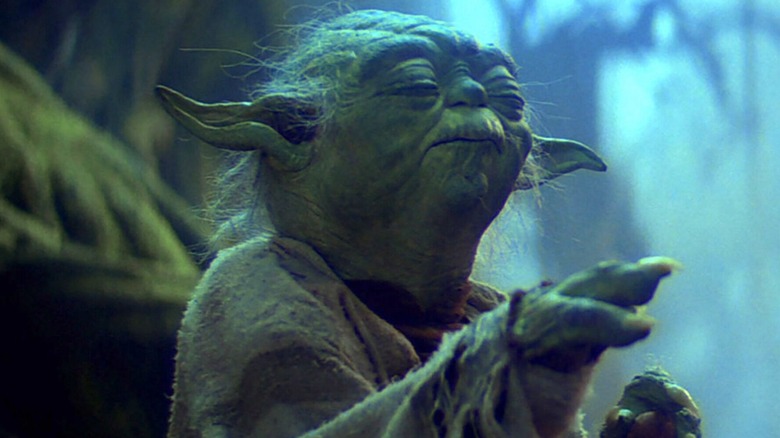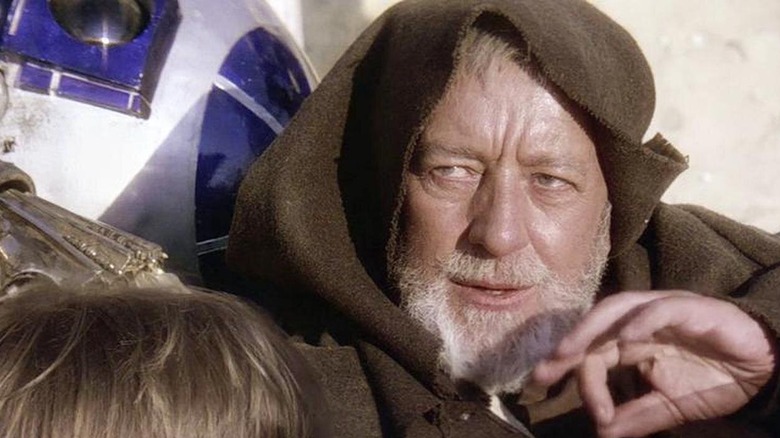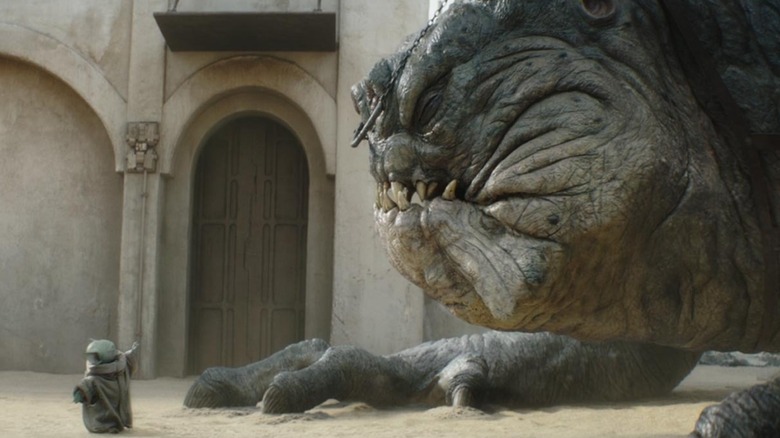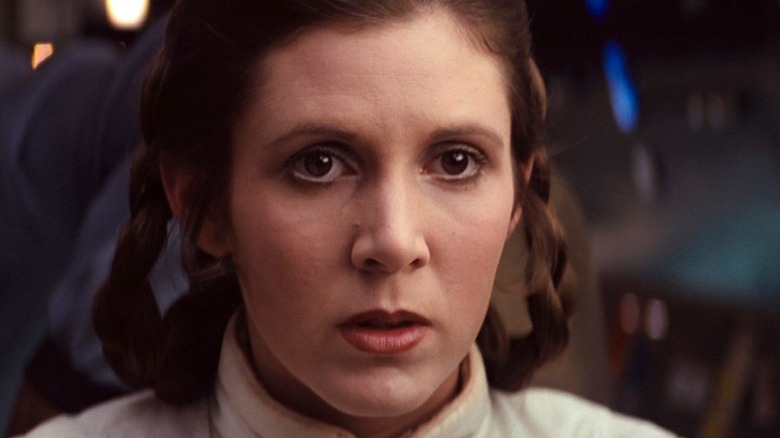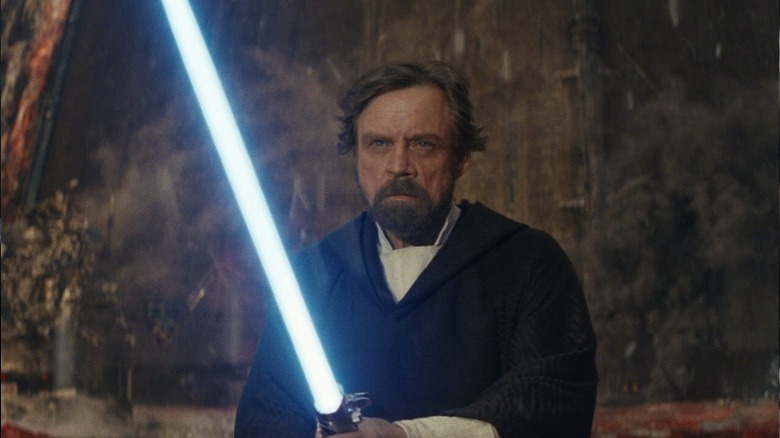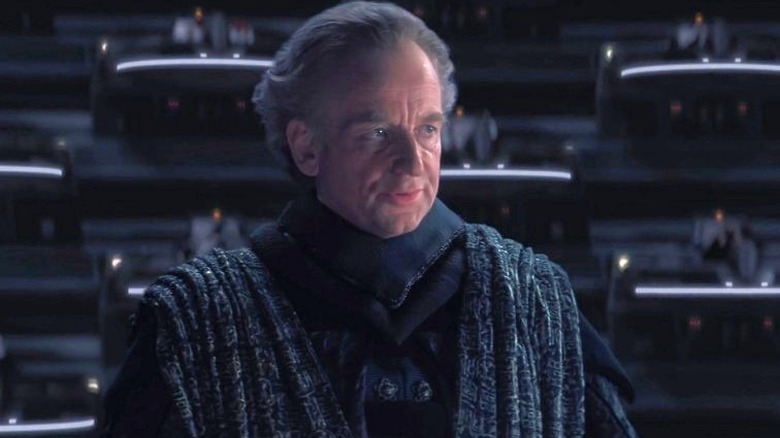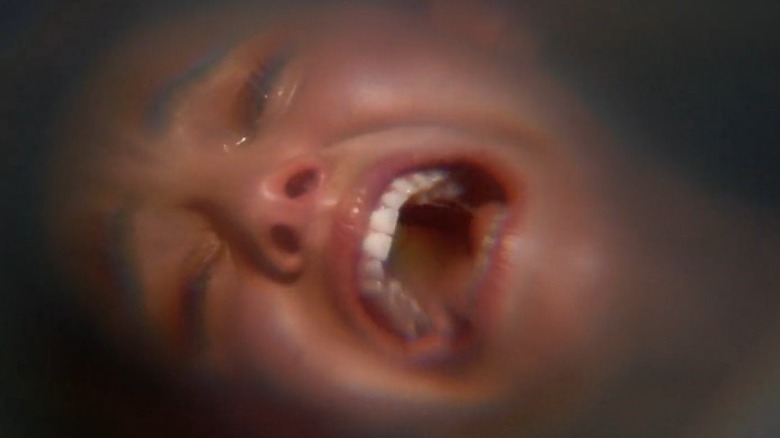6 Force Powers That Changed The Star Wars Galaxy
With the proliferation of Star Wars movies, video games, novels, and television shows, fans have seen all kinds of Force powers deployed by both Sith and Jedi. Did you know Force users could whip up storms? "Rebels" viewers do! How about using the Force as a passive physical shield? Baby Yoda can do it all day long.
The original trilogy left the impression that the Force operated by a certain set of unspoken rules, forging a connection with the universe that anyone could tap into and wield. That changed when the prequel movies introduced the midi-chlorians, making the Force something that's only available through genetic transmission. However, what matters is not who holds these powers, but how they're used. Making an enemy become so dizzy that they vomit (this is an actual, once-canon Force power) might impress your date, but it's not necessarily an effective technique when you're battling a Sith lord, no matter how much Force lightning your lightsaber can absorb. One small mind trick here and a moment of conversation with the dead there is more likely to tip the balance of power across the galaxy.
Here are six of the Force powers had the biggest impact on Star Wars, for better and for worse. They affected not only the overall storyline of the franchise, but the themes that made us love it to begin with.
The Jedi mind trick
In "A New Hope," Obi-Wan Kenobi waves his fingers at a stormtrooper, mystically convincing him that R2-D2 and C-3PO aren't the droids he's looking for. Look, it would have been an awfully short movie were it not for those 10 seconds in the landspeeder.
However, these few moments add up to more than a simple plot device to let the main characters slip past the bad guys. Until this point in the film, audiences have heard Obi-Wan speak about the Force, they've listened to Vader refer to it as powerful, and they've seen the Sith Lord briefly employ it in service of the dark side. But this scene is the first glimpse the viewer gets of how the Force can be used as a subtle weapon for civil defiance, virtuousness, and pushing back evil.
As a result, we learn that Force can cut for good as well as evil, just like the lightsaber Kenobi openly carries. This is just the beginning, of course. Later Star Wars media greatly expanded on the Force's capabilities. Still, this was the moment that a spiritual mysticism first entered a universe hitherto populated by robots, faster-than-lightspeed engines, and laser guns. It changed not just the Star Wars galaxy, but ours, too.
Animal kinship
In "The Book of Boba Fett," the Mandolorian and his charge fight Fett's rancor. With Din Djarin down, Grogu toddles into the line of fire and calms the beast. This moment between father and surrogate son carries a momentous meaning beyond being an easy "Get Out of the Rancor's Mouth Free" card. Grogu's actions mirror two earlier moments in the franchise: Luke's battle with the rancor in "Return of the Jedi," and Grogu's earlier assistance to Din on "The Mandalorian."
In "Return of the Jedi," the rancor is framed as a mindless, savage adversary for Luke to defeat. However, in the film's novelization, Luke understands that the rancor is simply hungry and abused, not evil — unfortunately, the only way out of the pit is lethal violence. Thematically, defeating evil via goodness isn't the focus quite yet. Lucas and director Richard Marquand save that for Luke's rescue of Vader in the finale. Besides, offscreen, the beast control Force power just wasn't a thing.
Grogu, on the other hand, practiced for decades in the Jedi Temple, and probably learned this skill as a youngling. Unlike his encounter with the mudhorn, he isn't exhausted by defending himself and his father, and won without injuring his adversary or relying on Mando's bounty-hunting skills. Just as the mudhorn sequence reveals Grogu's powers, his encounter with the rancor shows that he's rediscovered the Force. However, instead of wielding it like a blunt object, he controls it with far more finesse, taking a small step towards fulfilling his destiny as a Jedi.
Force bonding
While still reeling from the revelation that Darth Vader is Luke Skywalker's father, filmgoers received another surprise: Leia can sense when Luke is in trouble. A late scene in "The Empire Strikes Back" shows an injured Luke answering "Father" when the Sith Lord reaches out to him through their Force bond, telling Luke that joining the dark side is his destiny. However, for our purposes, the more important revelation comes when Luke sends out a distress call to his twin. How did he know to do that — and how did she know exactly where Luke was? The Force, of course.
Importantly, Luke doesn't ask Leia for comfort. He's already learned his lesson about the perils of acting rashly because of his attachment to others. Instead, he asks for help, and while he doesn't know that Leia is his sister, he's (consciously or otherwise) discerned enough about her Force-sensitivity to know that she'll hear him. The unveiling of Vader's secret overshadows this moment, but this scene shows how much Luke has grown, and retroactively offers the first hint at the connection between the Skywalker twins.
Force projection
While this Force ability first appeared in the 1992 comic "Star Wars: Dark Empire," the power of projection wasn't widely known until "The Last Jedi," when Luke sends his image across the galaxy to help the Resistance escape from Kylo Ren and the First Order. Its use emphasizes Luke Skywalker's vow to defeat evil without harming others — in this case, the son of Han Solo and his twin sister.
It's a moment that has its roots in Luke's training on Dagobah, where he enters a dark side-aligned cave and fights a vision of Vader wearing his own face. In this sequence, Luke "defeats" Vader, but he does so under the influence of fear and violence. Luke instigates the battle, and he strikes down Vader in the same way that the Sith Lord killed Obi-Wan Kenobi. It's a warning against carrying fear and a desire for revenge within him.
Luke inverts these events in "The Last Jedi." After spending the bulk of the movie agonizing over his legacy, Luke's choice to project a realistic vision of himself — one that, unlike the spectral Vader in "The Empire Strikes Back," relies on non-violent conflict resolution — is the surprise resolution of the film's third act. This tremendous effort costs the aged Jedi his life, but his sacrifice paves the way for the ultimate defeat of the First Order.
Obscuring understanding
How did the mighty Jedi fail to notice what Palpatine was up to until the last possible second? Why couldn't they see Anakin's fate, not even a little? The entire foundation of the Skywalker saga rests on the answer to these questions.
Yoda mentions that the Force can be used as a weapon of obfuscation in "Attack of the Clones." "The dark side clouds everything," he says, an explanation that Dooku repeats to Obi-Wan Kenobi at another point in the film. Lucas offers further insights in his commentary track: "It's not that they can't see the dark side coming, it's just that the dark side begins to envelop everything. It's like walking into a fog. The Jedi's ability to see lessens as the dark side grows ... As evil begins to take over, it pushes the Force out of balance."
In addition, the novel "Tarkin" suggests that there's a great font of dark side energy underneath the Jedi Temple. That raises a number of other questions, but could help explain why the Jedi are blind to Palpatine's machinations. Either way, the return of the Sith relies on an ability to hide in plain sight. This, combined with the Jedi's growing ineffectiveness and over-attachment to the Republic, is the true cause of the Order's downfall.
Visions of the future
Visions of the future often prompt the Skywalkers to make truly bad decisions. Thanks to his premonitions, Luke wanders into the trap Vader set for him in "The Empire Strikes Back." More importantly, visions of his mother's torment drive Anakin to seek bloody revenge; his attachment to Padme, and his forewarnings about her death, complete his turn. Anakin seeks power for what are ostensibly positive acts: fighting against slavery, and saving the lives of his wife and babies. But his efforts unleash unfathomable evil, and fulfill the very prophecies he's battling in the process.
Anakin's visions of Padme dying in childbirth doom him, but they don't have to. By using these moments as an excuse to assert control over others — a typical Sith characteristic — Anakin sets himself on a road to a living hell, albeit one paved with the best of intentions.
Although Anakin seeks Yoda's advice, he doesn't follow it when the Master doesn't tell him what he wants to hear. He also doesn't heed Obi-Wan's counsel that "dreams fade, in time." Instead, Anakin turns to the politician who strokes his fragile ego and makes incredible promises. We all know how that goes.
